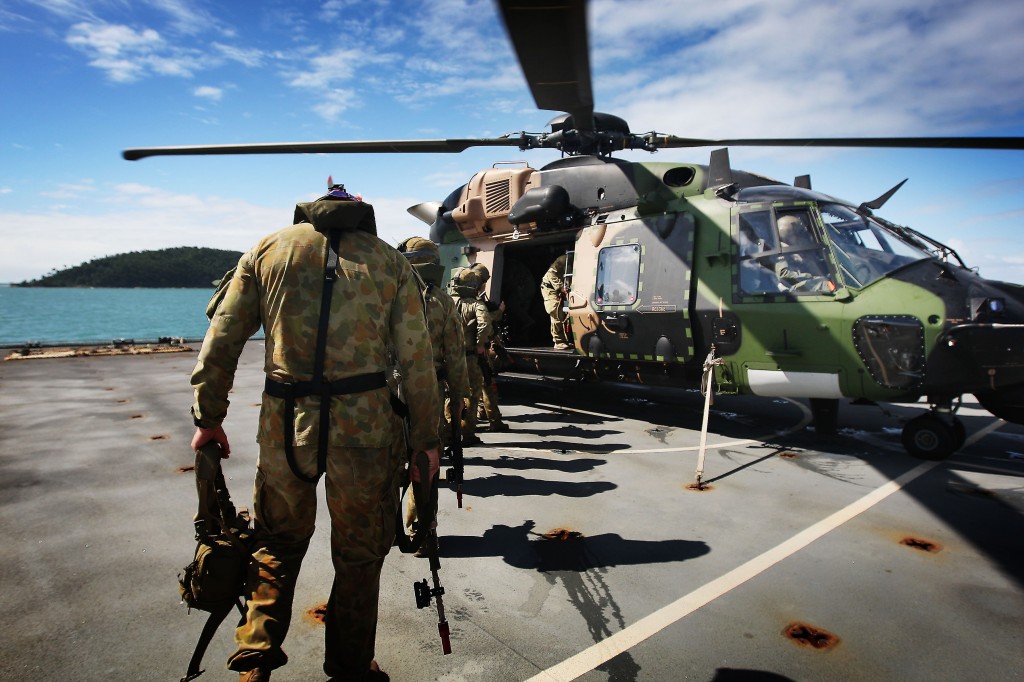The Chief of the Defence Force, General David Hurley, recently addressed the National Security Institute (PDF). He gave a tour de force tour d’horizon, focused on the development of the 2015 Defence White Paper (DWP). He explained the March 2015 deadline and also usefully mentioned (at least) three strategies and one non-strategy that the DWP might potentially be based on. Which will be chosen? Which should be chosen?
The first is the one articulated in the 2009 DWP, which could be summed up as ‘balancing against a future threat’. People assume that’s China, and the proposed force structure with its big-ticket item of 12 long-range submarines certainly suggests it. The 2009 DWP set out a big vision and even though funding realities intruded, its force structure remains the current plan, as CDF makes clear. This DWP was home alone. Other government initiatives were trying to build economic linkages with China while this DWP, so some say, was trying to sink them.
The second strategy CDF noted was an engagement one. This was the big idea that the 2013 DWP embraced. In sharp contrast to its 2009 predecessor, the ADF would now build linkages across the Indo-Pacific, including with China. The ADF would be less about defending Australia from Asia and more about working with Asia in Asia. The 2013 DWP was unusual in being consistent with other government documents and initiatives, particularly the Asian Century white paper. Institution building was in.
The third strategy—centred on trade—is a new one, and given CDF’s expansive position, probably better described as big ‘T’ Trade. This isn’t simply naval frigates escorting iron ore convoys but comprehensive Trade protection. And from CDF’s speech, presumably includes cyber defence, energy security, economic enablers, space and beyond. Service chiefs have also recently subscribed to this emerging narrative (here (PDF) and here (PDF)). And it’s in tune with Defence Minister Johnston who, when he became Defence Minister last year, articulated his strong focus on the defence of Trade as broadly conceived.
This position nicely resonates across the Abbott government with its focus on economic growth, business expansion, free trade agreements and a certain economic rationalism. This is a joined up domestic and foreign position; as the Foreign Affairs Minister, Julie Bishop, declared: ‘economic diplomacy is at the heart of the Government’s foreign policy’. More pithily, she observes, ‘economics is power and power is economics’. Many in government would agree.
This all augers well for a Trade strategy driving the next DWP and shaping force structure, with Defence both supporting and operating in harmony with the government’s broader policy settings. Indeed, it would make a fine grand strategy—perhaps a complex interdependence one?
A fine vision, but rather improbable. There’s a fourth option: the non-strategy of risk management. CDF noted that ADF force structure in recent years has been shaped by two ‘Principal Tasks’, ‘defending Australia from attack’ and ‘keeping the South Pacific and Timor-Leste stable’. These are tasks with no specific adversaries or deadlines to meet. The intent instead is to limit any damage arising if bad things happen, while hoping they don’t. In that view, the ADF is an insurance policy against certain well-defined risks. This isn’t a strategy as such, as no-one is working to achieve a desired objective or shape the future. The initiative lies with others and the focus is on having the force structure ready ‘just in case’.
This has actually been the default approach for most DWPs; the force structure is assigned a semi-permanent series of risk management functions. With the ‘Principal Tasks’ seen as enduring, the current force structure remains enduring as well. Declaratory strategies come and declaratory strategies go but the force structure remains, albeit occasionally renewed. The focus is on better risk management rather than implementing some new strategy, as the new amphibious ships exemplify; doing East Timor better, doing the South Pacific task better.
So the weight of precedent and inertia suggests that the actual strategy for the next DWP is likely to be a non-strategy of risk management. The advantage in that is the long-term force structure plans will need little change or adjustment. The new Defence Capability Plan (DCP) will bear startling resemblance to the old DCPs, albeit our current six submarines may now be planned to be replaced by six—radical stuff. The DCP will provide ‘a sustainable plan for Defence’ as CDF sets out, not some new strategic narrative. This isn’t to say that there won’t be a strategy noted briefly in a chapter of the DWP, but it’ll lead to a force structure surprisingly similar to the ones in the 2009 and 2013 DWPs—and the 1987, 1994 and 2000 ones as well.
So what? This risk management approach saw us through East Timor and the Solomon’s and allowed a modest contribution to Iraq and Afghanistan and the future could be just like the past. Worryingly, though, CDF’s speech suggests uncertainty on that point.
Having a strategy brings many things that risk management doesn’t, but an important aspect sometimes gets lost. Sir Lawrence Freedman defines strategy as: ‘about getting more out of a situation than the starting balance of power would suggest. It is the art of creating power’. With a good strategy, Australia will get more out of its force structure, and our ‘top 20 country’ will get more bang for its buck. Is that worth having? Is it worth the bother?
Peter Layton is an independent researcher completing a PhD on grand strategy at UNSW. He has been an associate professor at the US National Defense University. Image courtesy of Department of Defence.


